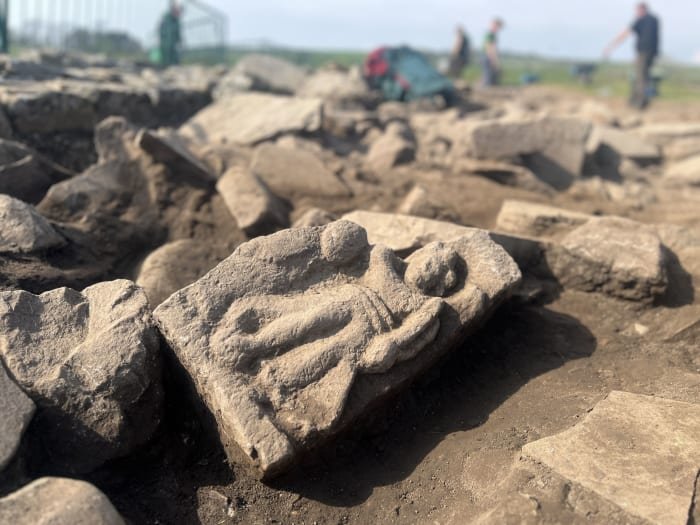Jan Bartek – AncientPages.com – Vindolanda, one of the earliest Roman forts established by the Roman army in England, stands as a significant archaeological site in Europe. It played a crucial role in guarding the Stanegate, the Roman road stretching from the River Tyne to Solway Firth. It was strategically located behind Hadrian’s Wall near Bardon Mill in Northumberland.
Credit: Phil Champion – CC BY-SA 2.0, Vindolanda Trust – Image compilation AncientPages.com
Over many years of excavation at Vindolanda, archaeologists have uncovered an array of remarkable artifacts, including skeletons, weapons, ruins, toys, and letters—each offering valuable insights into the ancient Roman presence in northern England.
Recently, a notable discovery has been made: a sandstone relief believed to depict the Roman goddess of Victory. This symbolic artifact was found repurposed within rubble above infantry barracks at Vindolanda and is thought to signify the conclusion of an ancient conflict.
Credit: Vindolanda Trust
Victory, known in Latin as Victoria, was the embodiment of triumph in Roman religion and mythology, serving as the equivalent of the Greek goddess Nike. She held significant importance among ancient Romans and was often credited with success on the battlefield during wartime. The stone relief is believed to be part of a larger piece that would have surrounded an inscription at its center. These specific barracks at Vindolanda were constructed around AD 213, following the Severan wars—a period marked by considerable upheaval for Romans in Britain.
Originally, these barracks featured a grand ornamental arch and gate where an inscription might have been located. The Victory relief is particularly meaningful as it symbolizes both the conclusion of conflict and the establishment of a fort at this site.
On May 1st, veteran volunteers Jim and Dilys Quinlan from Merseyside discovered this artifact while participating in their 21st year with Vindolanda’s excavation program, contributing to uncovering more about this remarkable location alongside archaeologists.
Credit: The Vindolanda Trust
Dr Andrew Birley, the Director of Excavations for the Vindolanda Trust said “finds like this are increasingly rare these days from Roman Britain, but the beautifully carved figure vividly reminds us that Roman forts were not simply utilitarian, they had grandeur and of course the symbolism was a vital part of the culture here for the soldiers almost 2,000 years ago. I am also delighted for Jim and Dilys for their discovery. It is just reward for their 21 years of hard work and dedication to this site”.
See also: More Archaeology News
This artifact is scheduled for public display in early 2026 at the Vindolanda museum as part of the Recent Finds exhibition. Given the successful start to the excavation season at Vindolanda, this exhibition promises to be a noteworthy event worth visiting.
Source: The Vindolanda Trust
Written by – Jan Bartek – AncientPages.com Staff Writer




